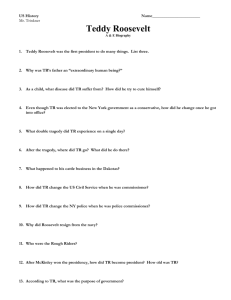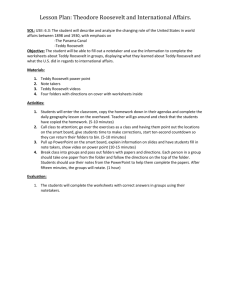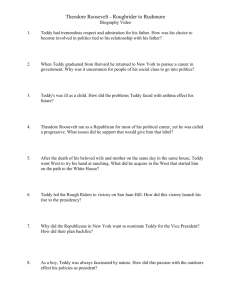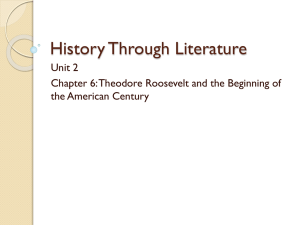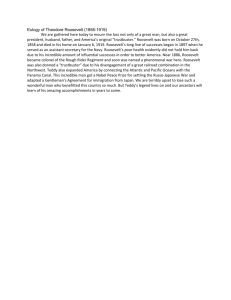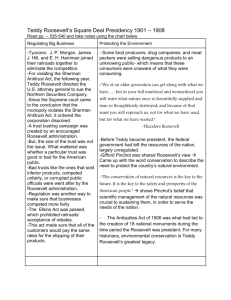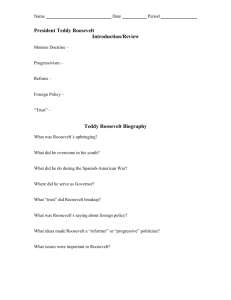Envisioning a Common Core Curriculum
advertisement
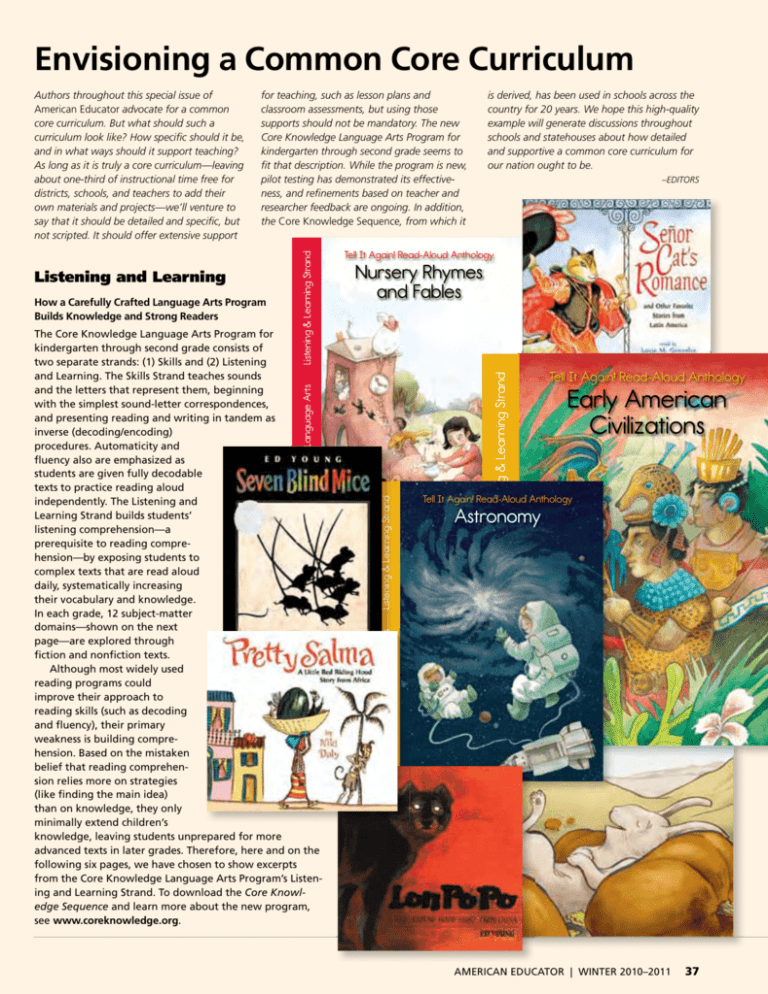
EnvisioningaCommonCoreCurriculum for teaching, such as lesson plans and classroom assessments, but using those supports should not be mandatory. The new Core Knowledge Language Arts Program for kindergarten through second grade seems to fit that description. While the program is new, pilot testing has demonstrated its effectiveness, and refinements based on teacher and researcher feedback are ongoing. In addition, the Core Knowledge Sequence, from which it ASTRO_Anth_Cover.indd 1 Listening & Learning Strand Tell It Again! Read-Aloud Anthology Early American Civilizations Tell It Again! Read-Aloud Anthology Astronomy Core Knowledge Language Arts Core Knowledge Language Arts The Core Knowledge Language Arts Program for kindergarten through second grade consists of two separate strands: (1) Skills and (2) Listening and Learning. The Skills Strand teaches sounds and the letters that represent them, beginning with the simplest sound-letter correspondences, and presenting reading and writing in tandem as inverse (decoding/encoding) procedures. Automaticity and fluency also are emphasized as students are given fully decodable texts to practice reading aloud independently. The Listening and Learning Strand builds students’ listening comprehension—a prerequisite to reading comprehension—by exposing students to complex texts that are read aloud daily, systematically increasing their vocabulary and knowledge. In each grade, 12 subject-matter domains—shown on the next page—are explored through fiction and nonfiction texts. Although most widely used reading programs could improve their approach to reading skills (such as decoding and fluency), their primary weakness is building comprehension. Based on the mistaken belief that reading comprehension relies more on strategies (like finding the main idea) than on knowledge, they only minimally extend children’s knowledge, leaving students unprepared for more advanced texts in later grades. Therefore, here and on the following six pages, we have chosen to show excerpts from the Core Knowledge Language Arts Program’s Listening and Learning Strand. To download the Core Knowledge Sequence and learn more about the new program, see www.coreknowledge.org. –EDITORS Nursery Rhymes and Fables Listening & Learning Strand HowaCarefullyCraftedLanguageArtsProgram BuildsKnowledgeandStrongReaders is derived, has been used in schools across the country for 20 years. We hope this high-quality example will generate discussions throughout schools and statehouses about how detailed and supportive a common core curriculum for our nation ought to be. Tell It Again! Read-Aloud Anthology Core Knowledge Language Arts Listening and Learning Listening & Learning Strand Authors throughout this special issue of American Educator advocate for a common core curriculum. But what should such a curriculum look like? How specific should it be, and in what ways should it support teaching? As long as it is truly a core curriculum—leaving about one-third of instructional time free for districts, schools, and teachers to add their own materials and projects—we’ll venture to say that it should be detailed and specific, but not scripted. It should offer extensive support EAC_Anth_Cover.indd 1 6/2/2010 1 6/2/2010 11:20:09 AM AMERICAN EDUCATOR | WINTER 2010–2011 37 Comprehension Relies on Knowledge Building Broad Knowledge: Key Domains Expand Children’s View of the World Kindergarten: Grade 1: Grade 2:* 1 NurseryRhymesandFables 1 FablesandStories 1 FairyTalesandTallTales 2 TheFiveSenses 2 TheHumanBody 2 EarlyAsianCivilizations 3 Stories 3 DifferentLands,SimilarStories 3 CyclesinNature 4 Plants 4 EarlyWorldCivilizations 4 TheAncientGreekCivilization 5 Farms 5 EarlyAmericanCivilizations 5 GreekMyths 6 NativeAmericans 6 MozartandMusic 6 Insects 7 KingsandQueens 7 Astronomy 7 WestwardExpansion 8 SeasonsandWeather 8 TheHistoryoftheEarth 8 TheU.S.CivilWar 9 ColumbusandthePilgrims 9 AnimalsandHabitats 9 Charlotte’sWebI 10ColonialTownsandTownspeople 10FairyTales 10Charlotte’sWebII 11TakingCareoftheEarth 11TheBirthofOurNation 11Immigration 12PresidentsandAmericanSymbols 12FrontierExplorers 12FightingforaCause Building Subject-Matter Knowledge: Solid Preparation for Academic Courses in Later Grades Literature Fictionisessential,butallstoriesarenot ofequalvalue.Theselectedfables, stories,myths,etc.,inthisprogramareas muchapartofbuildingsubject-matter knowledgeasthetextsaboutscience andsocialstudies.Fictionalworksappear ineachofthedomains,withstorieslike “Bear,Gull,andCrow”intheNative Americansdomainand“TheGrasshopper andtheAnts”intheSeasons and Weatherdomain. Science Frominsectstorainbows,childrenare verycuriousaboutthenaturalworld. Thesciencedomainsaresequencedto buildknowledgewithingrades—as kindergartnersprogressfromPlantsto FarmstoSeasons and WeathertoTaking Care of the Earth—andacrossgrades— aschildrenlearnaboutThe Five Senses inkindergartenandthenThe Human Bodyinfirstgrade. Social Studies Insteadofmerely“activating”children’s existingknowledgeoftheirfamiliesand neighborhoods,thesedomainsenlarge children’sknowledge.Carefulsequencing allowscontentandideastobuildon eachother—suchasbymovingfrom Kings and QueenstoColumbus and the PilgrimstoPresidents and American Symbolsinkindergarten,andonto The Birth of Our NationandWestward Expansioninfirstandsecondgrades. Building Coherent Knowledge: Big Ideas Draw on Multiple Domains and Subjects Inadditiontothedomainsbeingcarefullyselectedtobuildessentialsubject-matterknowledge,theyarealsopurposefully combinedwithinandacrossgradestodevelopcoherentknowledge.Takeacloserlookatthekindergartendomains.Severalofthe sciencedomainshelpstudentsbetterunderstandagriculture,whichisessentialtotheknowledgebeingbuiltinthesocialstudies domainssinceearlyAmericawaslargelyanagrariansociety.Anexampleofcarefullyconstructedcoherenceacrossgradesisthe progression(illustratedabovewithsolidpurplearrows)fromStoriesinkindergartentoDifferent Lands, Similar Stories,thenEarly World CivilizationsandEarly American CivilizationsinfirstgradetoEarly Asian Civilizations,The Ancient Greek Civilization,and Greek Mythsinsecondgrade.Looserbutstillvitalconnectionsarealsobuiltin,suchasthePlants,Farms,andSeasons and Weather domainsinkindergartensupportingcomprehensionofAnimals and HabitatsinfirstgradeandthenCharlotte’s Webinsecond grade(whichisillustratedabovewithdashedarrows). *Kindergarten and first-grade materials are currently available. Second-grade materials will be available in the summer of 2011. 38 AMERICAN EDUCATOR | WINTER 2010–2011 Knowledge Takes Time to Build one topic at a time is the most efficient way to build students’ knowledge and vocabulary. Mastering new topics and new words requires hearing, thinking about, and discussing them repeatedly. Sticking with a topic is also more engaging and Tell It Again! Read-Aloud Anthology Mozart and Music TABLE OF CONTENTS The Core Knowledge Language Arts Program Mozart and Music enjoyable, since the details (e.g., Mozart was a child prodigy who, at 5 years old, covered himself in ink as he began writing a concerto) are almost always more interesting than the introduction (e.g., Mozart was a composer). Tell It Again! Read-Aloud Anthology Listening & Learning Strand Listening & Learning Strand The Listening and Learning Strand of the Core Knowledge Language Arts Program contains 12 domains per grade, allowing each domain to be studied for at least two weeks using a variety of texts and content-related activities. This focus on Plants TABLE OF CONTENTS The Core Knowledge Introduction to Mozart and Music . . . . . . . . . . . . . . . . . . . . . . . . . iv Baby Brother . . . . . . . . . . . . . . . . . . . . . . . . . . .1 Lesson 2 On the Road . . . . . . . . . . . . . . . . . . . . . . . . . . 18 Lesson 3 Castles and Queens . . . . . . . . . . . . . . . . . . . . . . 34 Lesson 4 Operas and Symphonies . . . . . . . . . . . . . . . . . . . . 50 Lesson 5 Did a Child Write This? . . . . . . . . . . . . . . . . . . . . . 67 Lesson 6 Viva L’Italia! . . . . . . . . . . . . . . . . . . . . . . . . . . . 82 Pausing Point 1. . . . . . . . . . . . . . . . . . . . . . . . . . . . . . . . . 98 Lesson 7 First Great Works . . . . . . . . . . . . . . . . . . . . . . . .104 Lesson 8 A Terrible Loss . . . . . . . . . . . . . . . . . . . . . . . . .117 Lesson 9 The Price of Freedom: The Struggle. . . . . . . . . . . . . . .133 Lesson 10 Ups and Downs. . . . . . . . . . . . . . . . . . . . . . . . .151 Lesson 11 Dark Days. . . . . . . . . . . . . . . . . . . . . . . . . . . .165 Lesson 12 Mozart: Music Magician. . . . . . . . . . . . . . . . . . . . .178 Pausing Point 2. . . . . . . . . . . . . . . . . . . . . . . . . . . . . . . . .191 Domain Assessment . . . . . . . . . . . . . . . . . . . . . . . . . . . . . .197 Appendix . . . . . . . . . . . . . . . . . . . . . . . . . . . . . . . . .199 MOZ_Anth_Cover.indd 1 Introduction to Plants . . . . . . . . . . . . . . . . . . . . . . . . . . . . . . . iv Introduction to Plants . . . . . . . . . . . . . . . . . . . . . . .1 Plant Parts . . . . . . . . . . . . . . . . . . . . . . . . . . . 11 Lesson 3 The Life Cycle of a Plant . . . . . . . . . . . . . . . . . . . . 22 Lesson 4 The Gigantic Turnip . . . . . . . . . . . . . . . . . . . . . . . 33 Pausing Point 1. . . . . . . . . . . . . . . . . . . . . . . . . . . . . . . . . 42 Lesson 5 Polly the Honeybee’s Flowe r Tour . . . . . . . . . . . . . . . . 46 Lesson 6 The Fruits of Polly’s Labor . . . . . . . . . . . . . . . . . . . . 55 Lesson 7 Johnny Appleseed . . . . . . . . . . . . . . . . . . . . . . . 63 Lesson 8 Deciduous Trees . . . . . . . . . . . . . . . . . . . . . . . . 73 Lesson 9 Evergreen Trees . . . . . . . . . . . . . . . . . . . . . . . . . 83 Pausing Point 2. . . . . . . . . . . . . . . . . . . . . . . . . . . . . . . . . 92 Lesson 10 Interesting Plants and Plant Facts . . . . . . . . . . . . . . . . 95 Lesson 11 Plants and People. . . . . . . . . . . . . . . . . . . . . . . .105 Lesson 12 George Washington Carve r. . . . . . . . . . . . . . . . . . .114 Domain Assessment . . . . . . . . . . . . . . . . . . . . . . . . . . . . . .125 Appendix . . . . . . . . . . . . . . . . . . . . . . . . . . . . . . . . .127 6/3/2010 8:31:17 AM Lesson 1 Lesson 2 CVR_Plants.indd 1 6/2/2010 10:42:51 AM Language Arts Program Plants Core Knowledge Language Arts Core Knowledge Language Arts Lesson 1 Core Knowledge Language Arts Listening & Learning Strand Why Emphasize Read-Alouds? DLSS_cover.indd 1 © 2010 Core Knowledge Tell It Again! Read-Aloud Anthology Foundation Mozart and Music | Introdu ction Different Lands, Similar Stories iii Reading aloud to children is absolutely essential to building the knowledge that enables comprehension. Written language contains vastly more sophisticated vocabulary, ideas, and syntax than spoken language. So listening to a text read aloud has benefits that listening to a lecture, watching a movie, or engaging in a class TABLE OF CONTENTS The Core Knowledge Language Arts Program Different Lands, Similar Introduction to Different Stories Lands, Similar Stories . . . . . . . . . . . . . . . . . . iv Little Red Riding Hood . . . . . . . . . . . . . . . . . . . . . .1 Lon Po Po . . . . . . . . . . . . . . . . . . . . . . . . . . . 13 Lesson 3 Pretty Salma . . . . . . . . . . . . . . . . . . . . . . . . . . 25 Lesson 4 Tom Thumb . . . . . . . . . . . . . . . . . . . . . . . . . . . 39 Lesson 5 Thumbelina . . . . . . . . . . . . . . . . . . . . . . . . . . . 51 Lesson 6 Issun Boshi: One-Inch Boy . . . . . . . . . . . . . . . . . . . 67 Lesson 7 Mufaro’s Beautiful Daugh ters . . . . . . . . . 6/2/2010 10:32:54 AM . . . . . . . . . 79 Lesson 8 The Irish Cinderlad, Part I. . . . . . . . . . . . . . . . . . . . 93 Lesson 9 The Irish Cinderlad, Part II. . . . . . . . . . . . . . . . . . . .103 Pausing Point . . . . . . . . . . . . . . . . . . . . . . . . . . . . . . . . .115 Domain Assessment . . . . . . . . . . . . . . . . . . . . . . . . . . . . . .119 Appendix . . . . . . . . . . . . . . . . . . . . . . . . . . . . . . . . .121 Lesson 1 Lesson 2 discussion cannot provide (although these activities have their own benefits). In addition, students’ reading comprehension is not as advanced as their listening comprehension until they are 13 or 14 years old. The need for read-alouds in the early grades is obvious: young children cannot read at all, and children ages 5 to 8 are focused on decoding and gaining fluency. But even after age 9 or so, when most children can read some texts with comprehension, listening comprehension still far surpasses reading comprehension. Eighth-graders, for example, may be able to read their grade-level science textbook, but would still benefit from their teacher reading aloud a more advanced text, such as a popular book for adults by Isaac Asimov. Reading aloud is critical throughout elementary and middle school, even after students become independent readers. The knowledge and vocabulary they gain while listening will support their silent reading and allow them to move more quickly into advanced texts. © 2010 Core Knowledge Foundation AMERICAN EDUCATOR | WINTER 2010–2011 39 Plants | Introduction Read-Alouds Make for Rich Lessons To maximize students’ learning, each read-aloud comes with a complete lesson, including clear objectives for both the language arts skills and the content knowledge to be mastered, core vocabulary, comprehension questions, and a broad array of extension activities. There are also “Guided Listening Supports” that prompt teachers to explain vocabulary and ask questions to actively engage students in processing and responding while they listen. The lesson on the following three pages presents the “Teddy Roosevelt’s Hero” read-aloud, which is part of the Presidents and American Symbols domain in kindergarten. 7 Tell It Again! Read-Aloud Anthology an Symbols Introduction to Presiden ts and American Symbols . . . . . . . . . . . . . . . . iv The Home of the Presiden t: Washington, D.C. . . . . . . . . . .1 Lesson 2 A Dishonest Story Abou t an Honest Man . . . . . . . . . . . . 14 Lesson 3 A Clever General . . . . . . . . . . . . . . . . . . . . . . . . 25 Lesson 4 George Washington’s Spec tacles . . . . . . . . . . . . . . . . 38 Lesson 5 Thomas Jefferson’s Pen. . . . . . . . . . . . . . . . . . . . . 49 Lesson 6 Abraham Lincoln’s Hat . . . . . . . . . . . . . . . . . . . . . 60 Lesson 7 Teddy Roosevelt’s Hero . . . . . . . . . . . . . . . . . . . . . 72 Lesson 8 Teddy Roosevelt’s Bear . . . . . . . . . . . . . . . . . . . . . 82 Lesson 9 Carving Mount Rushmore . . . . . . . . . . . . . . . . . . . . 93 Pausing Point . . . . . . . . . . . . . . . . . . . . . . . . . . . . . . . . .104 Domain Assessment . . . . . . . . . . . . . . . . . . . . . . . . . . . . . .109 Appendix . . . . . . . . . . . . . . . . . . . . . . . . . . . . . . . . .111 Lesson 1 ts Introduction to Presiden and American Symbols kground information es the necessary bac This introduction includ erican Symbols Am the Presidents and to be used in teaching y for Presidents log tho An ud ain! Read-Alo domain. The Tell It Ag s, each of son les s contains nine daily and American Symbol lesson may the t tha so ts, two distinct par which is composed of at different ted presen r chunks of time and be divided into smalle total of fifty a uire req l wil . The entire lesson intervals during the day minutes. domain, after Pausing Point in this We have included one one to two days nd spe h to pause and Lesson 9. You may wis terial taught prior to the , or extending the ma reviewing, reinforcing n eleven days total re uld spend no mo tha Pausing Point. You sho on this domain. ogy, you will need: Along with this anthol ! Flip Book for Disk or the Tell It Again • Tell It Again! Media an Symbols Presidents and Americ s and American Symbol Cards for Presidents • Tell It Again! Image s erican Symbol for Presidents and Am • Tell It Again Workbook Core Vocabulary ctional Objectives and You will find the Instru e Student Choice/ lud . The lessons that inc for this domain below Cards, Parent ge Ima s, ion Book Extens Domain-Related Trade nts are also listed in Masters, and Assessme Letters, Instructional . the information below © 2010 Core Knowled ge Foundation CVR_Pres.indd 1 6/2/2010 5:30:09 PM rtant erican Symbols Are Impo Why Presidents and Am of four famous the lives and legacies This domain explores l national symbols, era sev to ts ces studen presidents and introdu erty, the White flag, the Statue of Lib including the American by learning in beg ts shmore. Studen House, and Mount Ru sident is, what a government, what a pre the basics about our sident. It is highly pre es om a person bec president does, and how © 2010 Core Knowledge iv | Introduction ts and American Symbols Presiden 40 AMERICAN EDUCATOR | WINTER 2010–2011 Language Arts Program Presidents and Americ Presidents and American Symbols Core Knowledge Language Arts Listening & Learning Strand TABLE OF CONTENTS The Core Knowledge © 2010 Core Knowledge Foundation Foundation recommended that you cover the Kings and Queens domain prior to this domain, because it will be beneficial to draw on students’ background knowledge of kingdoms to make a comparison between a king and a president. If you have already taught the Columbus and the Pilgrims domain, you may also draw on what students already learned about the Pilgrims who chose to leave England and later started a colony in America. This connection is important in two ways: Students will realize the Pilgrims wanted the freedom to worship as they pleased instead of what the king wanted; students will Presidents and American Symbols | Introd uction iii also understand what the colonies were, and how the Pilgrims were one of many groups of people to set up colonies in North America. It is important to draw on this background knowledge so that students can have a context when they learn about how George Washington fought against England and won freedom for the colonies, which then became the United States of America. Students start out by learning about two of our country’s founding fathers, George Washington and Thomas Jefferson. They will hear about the legend of Washington and the cherry tree, and his role as a general in the American Revolution and as the first president. They will then continue on to learn about Jefferson’s writing talent and the Declaration of Independence. Students will also learn that when the colonists decided to fight for their freedom from England, they themselves were keeping freedom from a large number of African-American slaves. The domain then covers Abraham Lincoln, the president of our country during the Civil War, and his role in ending slavery only about two hundred years ago. Finally, the domain segues to Theodore Roosevelt, who remembers as a child when Abraham Lincoln died, and how this hero made an impact on his growth as an adult and later his presidency. Students will also learn about Roosevelt’s love for the outdoors and how he worked for nature conservation. The domain concludes with a story about the carving of Mount Rushmore, which commemorates the four presidents presented in this domain: George Washington, Thomas Jefferson, Abraham Lincoln, and Theodore Roosevelt. Presidents and American Symbols | Introduction v 7 when, etc. ead-aloud, (L.K.15) i.e., who, w h • Answer qu estions that re qu ire judgments making inte , or giving rpretations opinions ab , aloud, includ out what is ing answer heard in a in g “why” ques recognizing tions that re cause/effect quir relationships • Make pe (L.K.17) rsonal conn ec tio ns to events aloud and/ or experienc or make co nnections am es in (L.K.19) ong severa l read-alo • Learn ne w words from read-aloud s and discus • Retell im sions (L.K portant fact s and inform ation from Core Vocab a read-aloud Teddy Roosevelt’s Hero Lesson Objectives es Core Content Objectiv Students will: ant president of the Roosevelt as an import • Recognize Theodore United States childhood health Roosevelt overcame • Know that Theodore problems Roosevelt loved the out • Know that Theodore ulary education, n. What so meone has Example: B learned ecause of he r good educ history. ation, Leah knew a lot Variation(s) about : none expert, n. So meone who knows a lo Example: Th t about a su e zookeepe bject r is an expe why they be rt on wild an have the w imals and ca ay th Variation(s) ey do. n tell : experts judge, v. To form an op inion about Example: Yo a person or u should no a situation t judge a pe get to know rson by his the person. or her looks; Variation(s) you sh : judges, ju dged, judg ing doors es Language Arts Objectiv Students will: ns, i.e., look at s for group discussio • Use agreed-upon rule take turns, say r, raise hand to speak, and listen to the speake e,” etc. (L.K.1) “excuse me” or “pleas over four to five A pate in a conversation t a Glance • Carry on and partici or responding to a nts initiating comme Exercise the of turns, staying on topic, ld What Have an adult or anotherInchi er Materials eith h wit , nts tr We Already me od ucing the Re partner’s com Learned? ad-Aloud .3) (L.K age e sam Personal Co nnections mental states, and s physical sensations, Presenting Purpose for the Read-Alo • Identify and expres Listening .4) ud (L.K others Teddy Roos emotions of self and evelt’s Hero Discussingnal the Read-Alo of texts, including fictio Comprehen iety var a d ud tan ers sion Questio al tion • Listen to and und ns , informa Word Work: les, historical narratives Expert stories, fairy tales, fab ) .11 (L.K Co ms m poe pl and Extensions ete Remaind text, nursery rhymes, er of the Le sson Later in Take-Home the Day Image Revi ) .13 (L.K s tion ew M stra at erial • Describe illu and Pa ck re che nt Letter d to panying the read-alou • Use pictures accom Instructiona loud (L.K.14) l Master 7B d-a rea the of g din tan -1 © 2010 Co support unders re Knowle Minut 10 10 7A Teddy Roosevelt’s Hero 10 5 15 dge Founda Introducing the | Teddy Roosevelt’s Hero bols 7Read-Aloud Sym 72 Presidents and American © 2010 Core tion Presidents an d American Symbols 7 | Teddy Roos ev elt’s Hero Knowledge Foundation 73 10 minutes What Have We Already Learned? Remind students that they have heard the stories of three former U.S. presidents so far in this domain. Tell students that you are going to say a statement about one of these great men and they d-alou ing, if possible, any rea are to name which of the three presidents the statement is about. and more complex language, includ tual fac rate ccu ina es lud t’s response inc Tell students their three choices: George Washington, Thomas vocabulary. If a studen and/or illustrations to earlier read-alouds k bac r Jefferson, and Abraham Lincoln. refe , information dings. rect any misunderstan • This president was admired for his honesty and has a cherry tree cor legend about him. (George Washington) Personal Connections people you admire • These two presidents were two of the Founding Fathers who Explain that heroes are Ask: What is a hero? e good things in don e helped create the United States of America. (George Washington to because they hav respect, and look up and Thomas Jefferson) their lives. Ask what these • This man had a talent for writing, and wrote the Declaration of who their heroes are. Have students share ire them so much. adm to ts Independence, a statement saying that the colonists were free cause studen people have done to ening to a story abo from England and had the right to live, to be free, and to be today they will be list Tell the students that ited States, Presid Un the happy. (Thomas Jefferson) t presidents of another one of the pas ts that, during the re Explain to the studen • This general fought England for American independence during Theodore Roosevelt. osevelt’s heroe ut one of President Ro the American Revolution. (George Washington) aloud, they will hear abo • This man became the first president of the United States. (George Washington) Purpose for Listening • This man became the third president of the United States. (Thomas Jefferson) • This man known as “Honest Abe” was president during the U.S. Civil War and hid a paper under his hat that said all slaves were set free. (Abraham Lincoln) Roosevelt had as for the struggles that Tell students to listen as he became an ms ble rcame those pro child, and how he ove velt’s hero and ose Ro re odo The identify adult. Ask students to velt’s father. hero of Theodore Roose Ask: “Which of these three presidents do you admire the most? What things have they done to make you feel this way?” AMERICAN EDUCATOR | WINTER 2010–2011 Remember to repeat and expand upon each response, using richer 41 Presenting the Read-Aloud Show imag e 7A -3: Lincoln 10 minutes Teddy though t about this. “D o you think Pr a good man, esident Father?” Tedd y greatly adm wanted to kn ired his fath ow how his fa 6 Does it sound like ther felt abou Mr. Roosevelt t the presiden admired President Mr. Roosevelt Lincoln? Why or replied, “I thin why not? k Abraham Li man, Teddy, ncoln wa and a great pr 7 or form an opinio esident. A gr of people and n about eat president do a lot of go c 8 What do you thin od things. Ab a poor family k it means that raham Lincol , but he work someone “hardly had ed ha two pennies rd . He was smar so many peop to rub together”? Ted t and k le liked him th dy’s father at he was ele is saying that some remember, Te cted presiden of the best dd y, you should people he has known 7 judge a man have been clothes he we not by the poor. ars or whethe r he lives in a by what he tri fancy part of es to do and t why. Why, so have known me of the be hardly had tw st p o pennies to ru Show imag b together.” 8 e 7A-4: Fr Teddy Roosevelt’s Hero Show image 7A-1: Theodore Roosevelt Everybody gets scared sometimes, but we can learn what to do about it. Today we are going to hear a true story about someone who decided that he would never let being scared stop him from doing what was right. This is a story about young Teddy Roosevelt. His mother called him “Theodore” when she introduced him to her friends. His own friends called him “T. R.” for short. His father 1 An education is what someone has learned. called him “Teddy” when saying something he especially wanted his son to remember. “Teddy,” he might say, “there is nothing more important than a good education,” and Teddy Roosevelt would listen. 1 Teddy always listened to what his father said. Show image 7A-2: Young Teddy watches Lincoln’s funeral train ail Teddy Ro osevelt 2 One day when Teddy was six years old, he and his younger brother, Elliott, were visiting their grandparents in New York City, 2 Describe what you see in the picture. where all the Roosevelt family lived. Teddy’s friend, Edith Carow (CARE-oh), was with them, but the children were not playing as they usually did. They stood by a window with Mr. Roosevelt, Teddy’s 3 A funeral is when people gather to honor someone who has died. 4 Who remembers something good that Abraham Lincoln did? 5 People are gathering out of respect for Abraham Lincoln. They want to say good-bye. 9 (Point to Teddy’s mother in the picture and note how she is peeking in on him bec ause she is worried about him.) father, and watched a train slowly moving by, not far from the house. Mr. Roosevelt said, “Inside that train is Abraham Lincoln, the president of the United States. President Lincoln died, and that train is taking him back to his home for his funeral.” 3 Show imag e 7A -5: Active Te Teddy asked, “Why is the train moving so slowly, Father?” “A lot of people loved Abraham Lincoln, Teddy, and thought knows as much as we do about this kind of animal or that kind of he was a very good man. 4 People are sorry he died. They want bird.” Teddy went to college and received the fine education his 10 Teddy followed Lincoln’s family to know this, and they are gathering along the train his father’s advice. father had talked about, and all his life, he gaveWhhis as much at doemind s this suggest to you tracks to show how much they will miss him.” 5 about how exercise as he gave his body. He wrote more than twenty books Teddy felt about his father? and many articles for newspapers and magazines. 11 or someone wh o knows a lot about Teddy’s father was his hero, so Teddy remembered the things a subject his father taught him. He never forgot what his father had taught him that day when President Lincoln went by. © 2010 Core Show image 7A-6: Theodore Roosevelt and Alice Lee 76 Knowledge Fou © 2010 Core Knowledge Foundation months after he finished college, Teddy married a young woman named Alice Lee. He studied to become a lawyer and wrote a book about the U.S. Navy, which navy officers agreed was the best book on the subject. Then he started to work in the government of the state of New York. Always doing a dozen projects at once, he did all of them well. Four years after Theodore and Alice married, Alice gave birth to a baby girl, whom they named Alice. Theodore had never been so happy. He loved his wife and new daughter and was now one of the New York government leaders, doing work he knew was helping people. Only two days after little Alice was born, however, Theodore’s lovely young wife became sick and died. Show image 7A-7: Roosevelt out West Heartbroken, Teddy asked his older sister, Anna, to care for the new baby. Then he left New York and traveled to South Dakota, a land of wide-open prairies. 12 He bought a cattle ranch, working alongside the cowboys he hired to move herds of cattle, trying to stay too busy to think about his sadness. There he began to feel healthy again. He wrote, “My ranch-house stands on the river brink. From the low, long veranda, shaded by leafy [trees], one looks across [to grassy] meadowland, behind which rises a line of [steep] cliffs. This . . . is a pleasant place in . . . summer evenings when a cool breeze stirs along the river and blows in the faces of the tired men, who [lean] back in their rocking-chairs [what true 78 Presidents and American Symbols 7A | Teddy Roosevelt’s Hero 42 AMERICAN EDUCATOR | WINTER 2010–2011 ddy Roosevelt Teddy listene d. Through ye ars of long, ha himself into so rd effort, he tu meone who wa rned s all action. He lifting weights built up his bo , becoming a dy st rong swimmer and box. He sp and learning to ent more and wre m or e time outdoo mountains, hik rs, climbing hig ing for miles an h d miles, and fi shing and hunt Teddy built up ing. 1 his mind, too. Hi s love for the him to learn all outdoors led about wild an imals, birds, such an expe 11 and fish. He rt that fam became ous scientists said, “Young Rooseve ndation Presidents and American Symbols 7A | Teddy Roosevelt’s Hero Two 12 Back then, far west of New York, there was much open land and many cowboys. But Teddy Ro osevelt rarely got out to mee people in diffe t different k rent parts of to wn . Mostly he st because he ha ayed quietly d medical prob lems that mad breathe. His e it hard for h mother worri ed that if he tri might get sic ed to be too k and die. 9 Hi activ s father thou said, “only yo gh t differently. “T u can decide e how you will your body inst live. I sugges ead of being t you af ra id to push it to the eye and te o hard. Look ll it, ‘I will not let you beat m watch while ot e. I will not ju her people do st s all the importa will truly live nt and excitin my life!’” g © 2010 Core Knowledge Foundation Presidents and American Symb ols 7A | Teddy Rooseve lt’s Hero American does not enjoy a rocking-chair?], books in hand . . . gazing sleepily out at the [hills] in the after-glow of sunset.” Show image 7A-8: Roosevelt the cowboy However, Teddy did not look quite like other cowboys. He wore glasses, and his cowboy outfit had been made for him by a t Lincoln was her, so he clothing designer back East. He also served as a deputy sheriff—a special kind of policeman—while living in the West. Once he nt. as a great 13 or people who had broken the law can help a lo t ln came from kind, and nt. 6 Always e kind of chased three outlaws 13 for days before catching and arresting them. Show image 7A-9: Roosevelt as a young politician Teddy loved the West, but little Alice was in the East. He missed his daughter, so at last he went home. He decided, “My father was right. If such a terrible thing as losing my wife can happen with no warning, I must use every day I have in this world to do important town, but people I things.” He started working in government again so he could help people. Theodore Roosevelt did not know it then, but he himself would one day become president of the United States. kinds of Discussing the Read-Aloud y at home him to 15 minutes Comprehension Questions ve, he eddy,” he u build up Who was Teddy Roosevelt’s hero as a child? (his father) 2. Why did Teddy’s father admire Abraham Lincoln? (Lincoln came from a poor family, worked hard, was a good leader, and was a kind, honest man.) 3. What was Teddy’s problem as a child? (He had medical problems that made it hard for him to breathe.) 4. What do you think gave Teddy the courage to build up his body and mind, even though he was a sick child? (the love and support of his father) k fear in sit and things. I d by estle h (10 minutes) 1. 5. 6. 10 What kinds of things did Teddy do because he enjoyed the outdoors? (climbed mountains; hiked; hunted; fished; Think Pair Sh are: What qu alities did you learned about wildlife; etc.) What kinds of things do you enjoy Roosevelt that hear about Te probably help ddy (Answers may vary.) ed him when outdoors? president? (A he became nswers may va ry.) Word Work: Ex pe e rt© 2010 Core Knowledge Foundation 1. elt Presidents and American Symbols 7A | Teddy Roosevelt’s Hero In the read-a (5 minutes) loud today, we heard that Te became an ex ddy Roosevelt pert in the ou tdoors and ab out animals. 2. Say the wo rd expert with me. 3. An expert is someone wh o knows a lo t about a topi 4. Someone c. is an expert if he or she knows very well or ca Extensions how to do so n answer mos mething t questions ab 5. Tell abou out a topic. t someone yo u know who Try to use the is an expert in word expert wh something. en you tell ab or three stud out it. (Ask tw ents. If necess o ary, guide an students’ resp d/or rephrase onses: “One the pe rs on ___. S/he is an I know who is expert in ___. an expert is ”) 6. What’s th e word we’ve been talking about? Use a Making Choices activ ity for followto describe so up. Directions me people. If : I am going any of the pe like an expert, ople I describ say, “expert.” e sound If any of the pe sound like an ople I describ expert, say, “n e don’t ot an expert. ” 1. someone who can answ er all your ques of bird (exper tions about an t) y type 2. someone who is just be ginning to lea rn to read (not 3. someone an expert) who takes ap ar t a watch, bu together again t cannot put (not an expert) it back 4. someone who knows ho w to fix any pr computer (exp oblem with an ert) y 77 7B Complete Remainder of 80 Presidents and Am erican Symbols 7A | Teddy Ro osevelt’s 79 elt’s Teddy Roosev Hero Image Review students t -9. Have the -1 through 7A 7A have lea es ag ey th im at Show ure and wh e in each pict udents share, st e th what they se As e. g rich with the pictur is associated response usin nd upon each pa ex any re d le, an ib at ss to repe ding, if po language, inclu more complex vocabulary. Parent Letter Send home In structional M aster 7B-1. the Lesson La ter in the Day Hero © 2010 Core AMERICAN EDUCATOR | WINTER 2010–2011 Knowledge Fou ndation 43
